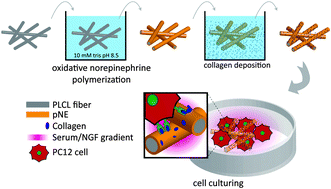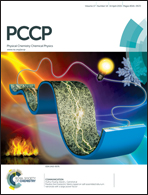Poly(norepinephrine) as a functional bio-interface for neuronal differentiation on electrospun fibers†
Abstract
Based on the catecholic chemistry of a mussel inspired coating, norepinephrine (NE), a catecholamine found both in neurotransmitters and mussel adhesive proteins, was for the first time applied as a unique bio-interface integrating multi-functions facilitating PC12 neuron-like differentiation. A uniform, ultra-smooth pNE coating was achieved on electrospun submicron PLCL fibers, proven by surface characterization. The introduced catechol groups from pNE were further used to not only anchor collagen to enhance cell adhesion but also localize nerve growth factor to promote neuron-like differentiation. The obtained pNE–collagen coating was found to be a superior substrate for PC12 differentiation, confirmed by both cellular toxicity/viability assays and immunochemical staining. The aligned PLCL fiber conformation further steered neurite formation along the fiber direction and contributed to neurite extension and increased the number of neurites per cell body. This facile pNE coating might lead to a more efficient use of growth factor, drugs and other bioactive molecules with lower loading dosage and sustained activity resulting in enhanced therapeutic effects and decreased adverse effects.


 Please wait while we load your content...
Please wait while we load your content...